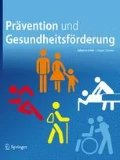Zusammenfassung
Hintergrund
Die Alterung des Immunsystems, die Immunseneszenz, ist die wesentliche Ursache für die Zunahme von Infektionen im Alter und damit verbundener Morbidität und Mortalität. Es ist ein multifaktorieller, noch unzureichend untersuchter Prozess, der Veränderungen und Dysfunktionen im angeborenen wie erworbenen Immunsystem auslöst, sowohl auf zellulärer als auch auf molekularer Ebene.
Ergebnisse
Die Immunseneszenz führt ferner zu einer geringeren Wirksamkeit von Impfungen, zum Symptomwandel, zu häufigeren Tumor- und Autoimmunerkrankungen sowie zur Zunahme sog. altersassoziierter Erkrankungen (z. B. Atherosklerose), denen eine erhöhte, meist subklinische Entzündungsaktivität zugrunde liegt („inflammaging“). Der geringeren Wirksamkeit herkömmlicher Impfstoffe im Alter kann z. B. mit der Anpassung von Impfstrategien begegnet werden oder durch eine Erhöhung der Immunogenität der Impfstoffe. Dazu kommen sowohl höhere Antigendosierungen als auch verschiedene Adjuvantien oder andere Applikationswege wie z. B. die epi-/intradermale Immunisierung zur Anwendung.
Schlussfolgerung
Trotz reduzierter Wirksamkeit im Vergleich zu Jüngeren bleiben Impfungen auch im Alter ein wesentliches Standbein der Prävention.
Abstract
Background
The aging of the immune system, so-called immunosenescence, is well documented as the cause of increased infection rates in the elderly with increased morbidity and mortality rates. Immunosenescence is multifactorial and incompletely understood. It includes malfunctioning of the innate and adaptive immune system on a cellular and molecular level.
Results
It can lead to decreased efficacy of vaccination, change of typical symptoms, increased susceptibility to cancer and autoimmune diseases as well as diseases associated with chronic stimulation of the innate immune system (inflammaging) such as atherosclerosis. Because of the decreased response to vaccination it is important to develop strategies to overcome the reduced immune responsiveness of this vulnerable population. There are different approaches: optimisation of vaccination schedules, enhancing the immunogenicity of vaccines by increasing doses of antigens, using adjuvants or developing new routes of administration, e.g. the epi- or intradermal route.
Conclusion
In spite of the decline in immune response due to immunosenescence vaccinations constitute the most cost-effective medical procedure for preventing morbidity and mortality caused by infections.
Literatur
Arnou R, Icardi G, De Decker M et al (2009) Intradermal influenza vaccine for older adults: a randomized controlled multicenter phase III study. Vaccine 27:7304–7312
Aspinall R, Del Giudice G, Effros Rb et al (2007) Challenges for vaccination in the elderly. Immun Ageing 4:9
Aw D, Silva AB, Palmer DB (2007) Immunosenescence: emerging challenges for an ageing population. Immunology 120:435–446
Bader MS (2007) Immunization for the elderly. Am J Med Sci 334:481–486
Castle SC, Uyemura K, Rafi A et al (2005) Comorbidity is a better predictor of impaired immunity than chronological age in older adults. J Am Geriatr Soc 53:1565–1569
Della Bella S, Bierti L, Presicce P et al (2007) Peripheral blood dendritic cells and monocytes are differently regulated in the elderly. Clin Immunol 122:220–228
Effros RB (2005) Roy Walford and the immunologic theory of aging. Immun Ageing 2:7
Evers SM, Ament AJ, Colombo GL et al (2007) Cost-effectiveness of pneumococcal vaccination for prevention of invasive pneumococcal disease in the elderly: an update for 10 Western European countries. Eur J Clin Microbiol Infect Dis 26:531–540
Gavazzi G, Krause KH (2002) Ageing and infection. Lancet Infect Dis 2:659–666
Gruver AL, Hudson LL, Sempowski GD (2007) Immunosenescence of ageing. J Pathol 211:144–156
Guy B (2007) The perfect mix: recent progress in adjuvant research. Nat Rev Microbiol 5:505–517
High K (2007) Immunizations in older adults. Clin Geriatr Med 23:669–685
Kovaiou RD, Herndler-Brandstetter D, Grubeck-Loebenstein B (2007) Age-related changes in immunity: implications for vaccination in the elderly. Expert Rev Mol Med 9:1–17
Kumar R, Burns EA (2008) Age-related decline in immunity: implications for vaccine responsiveness. Expert Rev Vaccines 7:467–479
Levin MJ, Oxman MN, Zhang JH et al (2008) Varicella-zoster virus-specific immune responses in elderly recipients of a herpes zoster vaccine. J Infect Dis 197:825–835
Murphy K, Travers P, Walport M (2009) Janeway immunologie. Spektrum Akademischer Verlag, Heidelberg
Nichol KL (2003) The efficacy, effectiveness and cost-effectiveness of inactivated influenza virus vaccines. Vaccine 21:1769–1775
Pawelec G (2005) Immunosenescence and vaccination. Immun Ageing 2:16
Shurin MR, Shurin GV, Chatta GS (2007) Aging and the dendritic cell system: implications for cancer. Crit Rev Oncol Hematol 64:90–105
Solana R, Pawelec G, Tarazona R (2006) Aging and innate immunity. Immunity 24:491–494
Ueno H, Klechevsky E, Morita R et al (2007) Dendritic cell subsets in health and disease. Immunol Rev 219:118–142
Weinberger B, Herndler-Brandstetter D, Schwanninger A et al (2008) Biology of immune responses to vaccines in elderly persons. Clin Infect Dis 46:1078–1084
Interessenkonflikt
Der korrespondierende Autor gibt an, dass kein Interessenkonflikt besteht.
Author information
Authors and Affiliations
Corresponding author
Rights and permissions
About this article
Cite this article
Kwetkat, A. Immunologie im Alter. Praev Gesundheitsf 5 (Suppl 1), 46–50 (2010). https://doi.org/10.1007/s11553-010-0228-3
Published:
Issue Date:
DOI: https://doi.org/10.1007/s11553-010-0228-3

